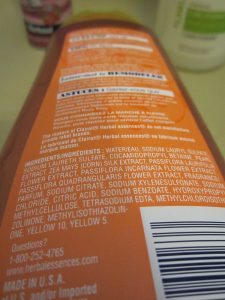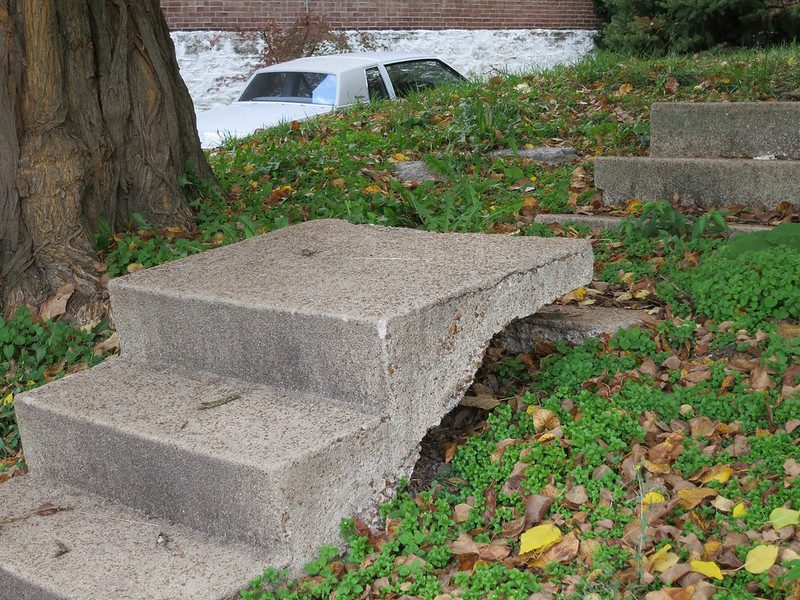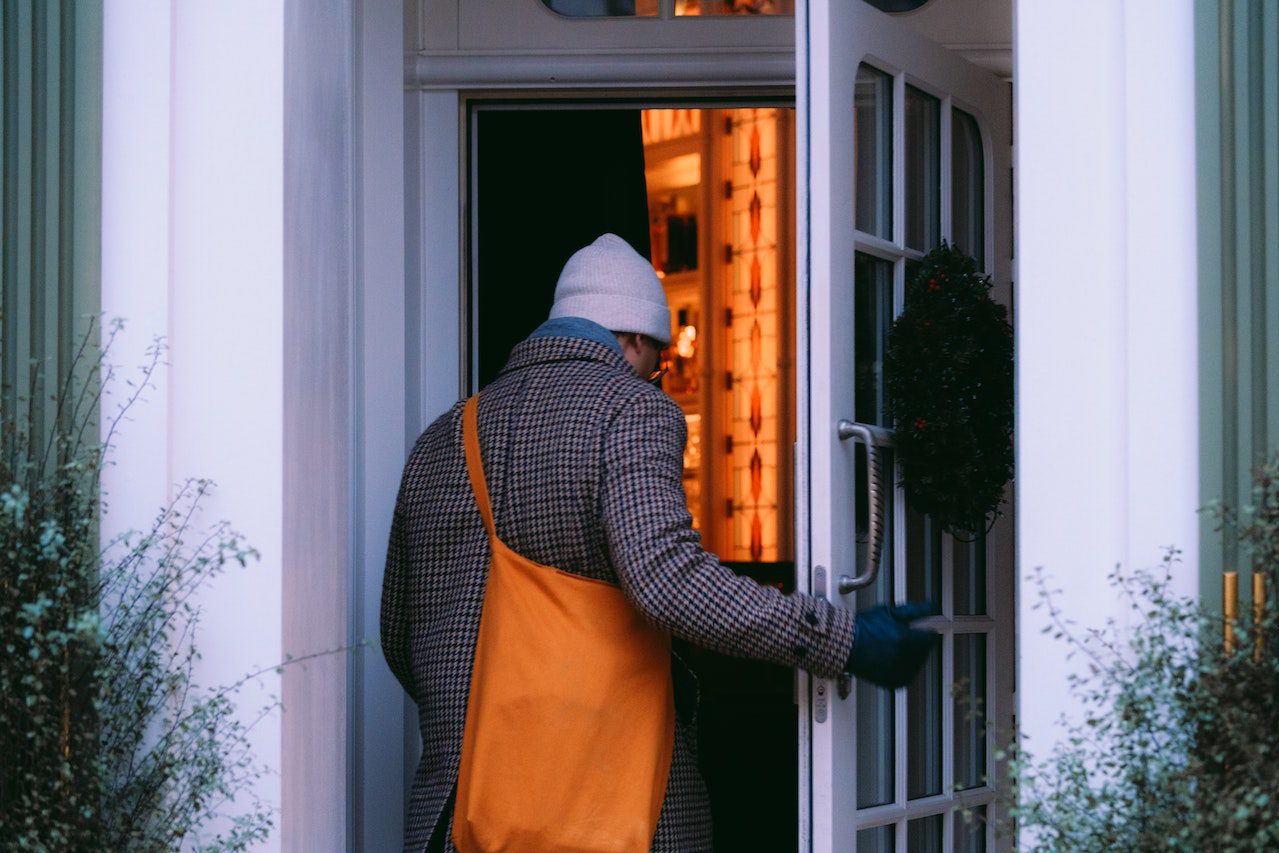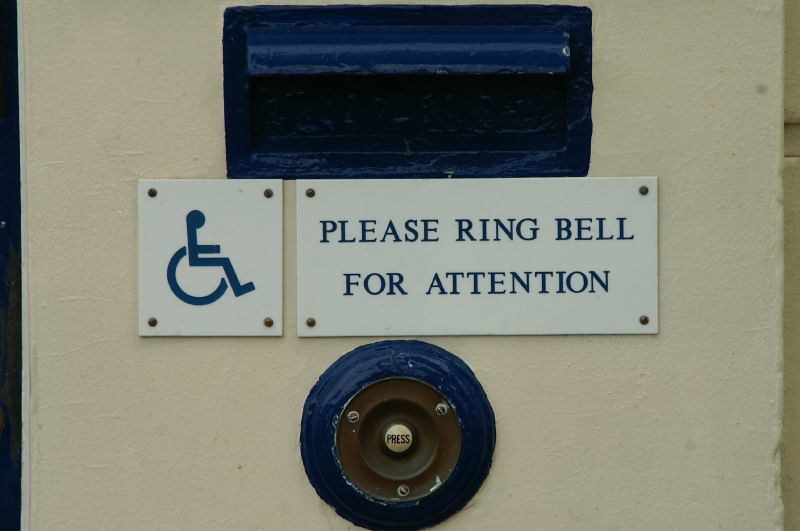This article is part of the Under the Lens series
Not Just Ramps—Disability and Housing Justice

Photo by Flickr user Caleb Woods, CC BY-NC-ND 2.0
Although accessibility features such as wheelchair ramps, curb cuts, wider doorways, and closed-captioning are still not nearly as universal as are needed, they have become increasingly expected, especially in public places.
But people with less visible or less well-understood disabilities often find themselves unable to live in, work in, or even pay a brief visit to places that most of us take for granted as safe or accessible. Multiple chemical sensitivity (MCS) is a prime example of such a disability. People with MCS can experience adverse or disabling effects—headaches, nausea, breathing difficulties, heart palpitations, and even cognitive impairment—from chance exposures to fragrances, cleaning products, and chemicals hidden within a building’s walls, flooring, carpeting, and paint.
Chemical exposure hazards occasionally make headlines when large groups such as 9/11 responders or war veterans seek compensation for adverse health impacts—or when celebrities take up their cause—and after disasters like the East Palestine, Ohio, train derailment that exposed residents to vinyl chloride and other chemicals. But people with MCS experience health problems from much smaller exposures, and exist under the radar, striving on their own or collectively to find or create safer environments.
‘So Many Places I Can’t Go’
Karen Kenning became ill after long-term exposure to art supply chemicals at work. She recalls that workplace had no ventilation, a requested air filter that was actually an “oven fan” dumping air back into the workplace instead of outside, and a malfunctioning kerosene heater that stood at face level. When she left that job and went to work as a union carpentry apprentice, exposure to concrete forms coated with oil made her even sicker.
“I was getting lost on my way to work, I was hallucinating. I would sleep in the car to make sure I got to work the next day. One breath of diesel fuel would put me in bed for a month,” Kenning says. Still, 13 years went by before her condition was diagnosed as MCS.
She stopped working, but still had to avoid being near all chemicals and fragrances. She pitched a tent and lived outside for five years on rural land she owned in upstate New York.
Laura Ramos of rural New Jersey says she has a “panorama” of disabilities, including MCS and environmental illness (EI), which have made finding suitable affordable housing a frustrating, decades-long struggle.
“With apartments, the landlord might spray outside, your neighbors may spray things, from air fresheners to pesticides. If I had my own house I could control all that,” she says. Another problem in multi-unit buildings, she says, is shared laundry rooms, where tenants might encounter fragranced laundry and cleaning products or machines that have developed mold.
An injury at work some 20 years ago led to mobility issues as well, and Ramos relies on a quad cane, walker, or wheelchair. While in the past she has had to fight for adequate mobility accommodations, leading her to start a disability advocacy nonprofit, that was easier than finding an apartment that doesn’t exacerbate her chemical and environmental sensitivities, she says.
“The MCS/EI has been more limiting to my everyday life and independence than the need for a wheelchair,” she says. “When I finally got a really good power wheelchair and had room to really put it to a test, I could fly! Like when I would go running as a track athlete in high school and college. And with a mobility van, I could go everywhere. But with MCS/EI, there’s so many places that I can’t go.”
As one example, she stopped attending meetings in public places after encountering perfumes and cleaning agents that rendered her unable to breathe. Formerly an assistant professor of public health, Ramos, 65, now volunteers, helping others with housing and disability issues.
When Your Home Makes—Or Keeps—You Sick
Typical apartment buildings present a minefield of potential triggers for MCS sufferers. Within a unit, paints, carpeting, vinyl flooring, upholstery, and composite wood products like plywood can contain volatile organic compounds (VOCs) such as formaldehyde or polyfluorinated alkyl substances (PFAS) that continue for a time to “off-gas” into the air occupants breathe. While these may go unnoticed by healthy residents beyond a “fresh paint smell,” any amount could be intolerable for people with MCS.
Peril lurks in common areas, too.
“Shared entries, hallways, facilities like laundry rooms, parking garages, or outdoor spaces can be rendered completely inaccessible if there is a presence of perfumes, fragrances, smoke, cleaning agents, fertilizers, and so on,” says Shelby Seier, founder of All Kinds Accessibility Consulting in Omaha, Nebraska. “[And] turnover and construction—for example, repainting and repairs between tenants—can cause totally debilitating symptom flare-ups, which impact every facet of life.”
‘There’s no compromising with this disability. We need to own and manage our own housing. Let us do it ourselves. Give us the funding to allow us to live our lives.’
It’s not easy to locate disability-accessible housing even when it does exist, Ramos notes. On a state-approved affordable housing search website and on national apartment search sites, she can search by location or by rental vs. ownership units, but not by accessibility features. The number of residential buildings constructed with both MCS and mobility disabilities in mind is vanishingly small; one model she cites is Ecology House in San Rafael, California, the first such apartment building funded by the Department of Housing and Urban Development (HUD)—but its 11 units are a tiny drop in the vast bucket of need.
While Universal Design standards, also called “inclusive design” or “design for all,” aim to make all housing units function equally well for people with and without disabilities, such one-size-fits-all standards don’t go far enough to meet varied needs, argue some disability scholars and people with less-common disabilities, like Ramos and Kenning.
“Universal design so far hasn’t been willing to encompass chemical sensitivity issues,” says Kenning, though in theory it could go further.
Location, however, poses conflicts with other accessibility and affordability goals. Ramos and Kenning note that affordable and accessible housing is often intentionally sited in denser urban areas in order to be transit-accessible and near services and jobs. But being surrounded by traffic-clogged streets increases the chances of air pollution. Cheaper land in rural areas where affordable housing might go could be near areas of high pesticide use or quarries that add particulates in the air.
And while the increasing incentivization of “green” affordable housing is a positive for climate change mitigation, environmental sustainability, and lower heating and cooling costs, Ramos says that without other changes, the tighter building envelopes required by energy efficiency standards have resulted in poorer indoor air quality, with less fresh air to waft away the off-gassed chemicals.
HUD, ADA, and Fair Housing Act Accommodations
A complicating factor for people seeking accommodation and treatment for MCS is that its existence is still under debate in the medical community and in courts. The World Health Organization’s International Classification of Diseases list does not include MCS.
In the U.S., disability discrimination is prohibited by the Americans with Disabilities Act, the Fair Housing Act, Section 504 of the 1973 Rehabilitation Act, which covers recipients of HUD financial assistance, and by other state and local laws, but it’s not clear what accommodations might be required for MCS. The ADA doesn’t name specific recognized disabilities; the ADA’s explanation of a person with a disability is “a person who has a physical or mental impairment that substantially limits one or more major life activity.” Accommodation decisions for MCS are therefore based on whether the resulting symptoms thwart key life activities.
A HUD spokesperson confirmed in an email: “When considering whether any condition is a disability, HUD applies the statutory and regulatory requirements under the Fair Housing Act, Section 504 of the Rehabilitation Act, and the Americans with Disabilities Act, as applicable. . . . Because conditions that often fall within the category of MCS individually affect a variety of major life activities, individual circumstances would determine whether an individual is covered by these disability definitions.”
HUD’s Fair Housing Act Design Manual, however, primarily addresses safety and movement accommodations for people with mobility, visual, hearing, and cognitive disabilities.
What Would MCS-Safe Housing Look Like?
So what would it take for housing to be MCS-friendly? Seier, the accessibility consultant, can tick off a litany of requirements: “We need relief from mold, from standing water, from poor water quality, from harsh chemicals, from airborne viruses, from dirty surfaces, from rodents and pests, and so on.”
Also, to have a chance of healing, people need to remain in a healthy space over time, she says. “Not only do we need spaces rid of toxicity, but we also need to be able to stay in the space long enough to recover from exposure.”

Photo by Flickr user GV, CC BY-NC 2.0
The Independent Living Research Utilization program at a Houston rehabilitation hospital offers a fact sheet and guide for independent living centered on ways to accommodate residents with chemical sensitivities. Recommendations include making building-wide pre-emptive policies that restrict the use of fragrances in everything from cleaning and laundry products to personal care items; minimizing or avoiding certain disinfectants; choosing integrated pest management methods; and using the least toxic paint and building products obtainable during renovations.
Besides limiting chemical exposure risks, Kenning would like to see a much larger cultural and political shift toward prioritizing taking precautions rather than reacting.
“In Europe and in Japan, they handle increasing chemicals differently. There’s a national policy of prevention, which puts health first. In Europe, there’s a conversation between government and corporations. Here, it’s between individuals and corporations—that’s an unfair power differential, and the individuals never win,” she says.
In Detroit, an employee lawsuit led to the city adding fragrance-free goals to its ADA guidelines. It’s not inconceivable that similar policies could emerge at housing complexes as well.
‘Let Us Do It Ourselves’
People with MCS acknowledge that a disability that makes it hazardous to be around traditional housing materials and around other people presents complex accommodation challenges.
With a dearth of real options, MCS sufferers have harnessed the internet to share resources and advice, including the Chemical Sensitivity Foundation’s compilation of news and videos; directories of MCS-safe living communities; tips on the least toxic tents, sheds, and trailers for emergency housing; and DIY hacks to modify home environments to be safer.
Seier suggests that in the absence of what’s really needed—healthy buildings, universal health care, and a strong social safety net—people suffering poor indoor air quality who can’t afford expensive HEPA filters might consider making a Corsi-Rosenthal box, which she calls an “ingenious and affordable air filtration solution.”
In some cases, people are taking charge of their living environment by creating their own MCS-friendly communities.
In Snowflake, Arizona, some 30 households of varying means live in scattered single-family homes across a large swath of desert land. The houses have been built with less-toxic materials and construction methods, and the community has a shared commitment to use safer, nonfragranced household products.
In New York state, the nonprofit Canary Housing Cooperative, of which Karen Kenning is a co-founder and the secretary, is on a mission to create a series of small limited-equity housing cooperatives in New York state “dedicated to the restricted lifestyle required by chemically sensitive and electrically sensitive people” and open to multiple income levels.
Kenning explains that the plan is “intentional housing” that would offer a transition time for residents to try out the house and make sure it’s a good fit—a kind of flexibility one would be hard-pressed to find in any larger-scale affordable housing.
The Canary team has, however, been beset by financial and bureaucratic obstacles. They’d located a farmhouse to renovate and were about to sign for a loan back in 2020, and then COVID-19 hit. Higher interest rates and material and labor costs left them unable to continue, and meeting HUD funding guidelines with their small project has proved frustratingly difficult.
Now the group is resuming the project, this time seeking private funding.
“Finding housing without pollutants is crucial to managing this life-altering and degenerative disability. There is currently no accessible and affordable housing for this disability in NYS, nor is there a funding path to create any,” Kenning wrote in a recent letter to Sen. Kirsten Gillibrand asking for assistance in identifying low-interest loan options that respect the co-op project’s accessibility requirements.
While waiting for loan options—or a winning lottery ticket, Kenning jokes dryly—Canary has launched a GoFundMe page to raise money to cover short-term operating costs.
At this point Kenning simply wishes for fewer barriers to accessing funding.
“I have banded with others. We have the disability; we know how to live with it,” she says. “There’s no compromising with this disability. We need to own and manage our own housing. Let us do it ourselves. Give us the funding to allow us to live our lives.”
A Push to Build With Less-Toxic Materials
While it’s a substantial challenge to create housing that fully accommodates the complex and individualized needs of people with MCS, one path forward is to significantly reduce the toxins in building products—which could have the added effect of keeping all of us healthier.
“A lot of the substances that harm people with MCS harm all of us,” says Alex Muller, vice president of strategy and communications at the nonprofit Mindful Materials. “We may not notice it in the same way. The more we learn about so many substances, the more we realize something could be problematic in other ways. Just because you’re not someone able to identify this sort of sensitivity, doesn’t mean you’re not impacted by it.”
Gina Ciganik is a former housing developer and current chief executive officer of Healthy Building Network (HBN), a national nonprofit working to increase transparency in the building products industry and provide easy-to-use information to help designers and builders choose the least toxic materials.
“Compared to 10 years ago, there is some conversation around the materials aspect,” she says. “All of the major buildings standards [such as LEED, WELL, Living Building Challenge and Enterprise Green Communities] have a materials section, but it’s still so far under the radar. Right now, people are focusing on green energy and decarbonization. That’s where all the ‘points’ are in the rating systems, and they may make materials more of an optional part. So it’s hard to talk about detoxification. But it has to be a both/and.”
Ciganik says there has been progress in manufacturer disclosure—helped along by the Health Product Declaration framework and the International Living Future Institute’s Declare label—but there are still a lot of unknowns and secrecy around chemicals.
“There are 85,000 chemicals in industry today to make different products, and less than 200 have had tests on whether they have health impacts and only a few have any sort of regulation,” she says. “I’m in this work now because I was shocked at how little we knew about the products we use in buildings, and their impacts all across the life cycle.”
HBN’s solution comes in the form of a red-to-green ranking system, sorted by product categories—flooring, drywall, insulation, for instance—rather than specific brands or chemical names.
“We created guidance that’s not written in ‘chemistry.’ It’s written in the terms developers and architects use,” Ciganik says.
She is seeing positive, if incremental, change. “The good news is that there are safer options that don’t cost more and perform as needed. We’ve yet to find an affordable houser who’s not been able to pick one or more safer products,” she says.
Having been a developer, Ciganik understands real estate budget considerations, she says. “You’re not going to fix all of it at once. Pick one thing, whatever fits your price. We can’t be afraid, or assume that we can’t do it because of cost or performance or code or chemistry or complexity.”
One promising program that encourages affordable housers to incorporate less-toxic material goals into green building goals is the International Living Future Institute (ILFI)’s Living Building Challenge Framework for Affordable Housing. Among the resources ILFI offers are checklists to help housing project teams vet materials, guidance for making sure project partners and workers are on board, and case studies of affordable housing projects that have successfully incorporated less-toxic chemicals cost-effectively.
“Our goal is to shift the paradigm from mitigating negative impacts to moving to positive impacts,” says Susan Puri, ILFI’s director of affordable housing. “A simple way to think of it is, we don’t’ want to do ‘less bad.’ We’re trying to figure out what good looks like—for example, net zero and no toxic products. Not ‘20 percent less,’ but all the way to good.”
A movement toward new, less-toxic products could spawn new economic opportunities, too. In Minnesota, HBN is partnering with the Lower Sioux Indian Community to build hemp farming and manufacturing capacity to make low-cost, sustainable “hempcrete” that can replace traditional wall materials, leading to less toxic indoor environments.
Looking Ahead
Kenning is heartened by the Biden administration’s increasing focus on flexibility and creativity in housing solutions, including last fall’s White House Summit on Improving Indoor Air Quality, and hopes it will spur attention that could help grassroots groups aiming to build MCS-safe homes. She is also encouraged by the work of Dr. Joseph Allen of Harvard School of Public Health, who has been sounding the call on indoor air quality as the next public health frontier.
Making healthy homes the norm, she notes, could also have massive cost savings.
“Changing the culture around cigarettes [in subsidized housing] saves $521 million per year,” she says. “We could have similar savings reducing chemicals. The population is paying the cost of those chemicals now, financially and in their health.”
|
Help keep us strong by becoming a Shelterforce supporter. |





Excellent article Sandra. Thank you. At now 84, my UK Nazi bombing COPD 1941.
Then, (coming to Canada in 1947) my MCS was providentially diagnosed 1974, here in Ontario.
We were able to complete our mortgage via a legal settlement, re promised, but unfulfilled, workplace disability Accommodation, 1999 . We spent thousands from our small pension over 20 years to Disability renovate our home. A too often ignored deadly, unavoidable, pollutant
wood smoke invades our home constantly. That pollutant is the highest form of air pollution
In Canada and causes many serious illnesses and premature deaths, with costs annually at $18 Billion. (Yes, I’ve spent all my retirement years constantly researching all aspects.)
One of the very best sources of vital information is DSAWSP.org
21 years ago, I gotten carbon monoxide poisoning it’s been a very long, hard road constantly moving trying to avoid chemicals and things that come in from the neighbors can’t live in apartments. Try now to live in a senior duplex because I’m gonna be 70 years old now every year gets worse for me there’s no help I cannot find a healthy environment to live in, I now have heart problems because of it. I have a deviated septum. I have nodules and cyst on my lungs and chest walls. People don’t know a lot about this if anything and they think it’s not real or your exaggerating are you sure you would not. It’s also affected my heart I now need to have surgery for my eyes. I’m not seeing very well, but I cannot go have the surgery and come back into the environment. I’m living in because I wake most mornings with my eyes swollen like hard boiled eggs , unable to breathe my nose, swollen twice the neighbors do not care what they’re doing even if it affects you exposed to mold I have searched out every level of housing department all the way up to federal. I have searched through organizations for help to get out of here when I need is a single unit to live in just like everybody else does, but there’s no help for us. There’s no grants for us if you have MCS. Until they live in. And because I choose to live a little longer and not die here I am also considering selling everything I own to buy a van to live in but again I’m going on 70 years old. It’s not gonna be easy it’s not easy where I’m at now. I spend many nights in the cold in the winter sitting on a bench outside just so I can breathe fresh air Landlord don’t care and help. What are we supposed to do? Is there anyone out there to help us at all people do not understand what this is like you have to know. All I need is a separate unit to live in. Like used mobile home. The ribs and the prices of used mobile homes are so expensive now seniors can’t afford to do this I can’t. I’m low income right now. I had to leave my job in my work before I was prepared for retirement that was 21 years ago. Not just trying to exist. We live in avoidance when something bothers us. We’re trying to figure out what it is so we can stop it but if it’s coming in from neighbors, they don’t care and it’s not going to stop and the management won’t stop in either. We are treated with discrimination because of it.